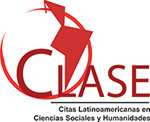Loom as an innovative tool to enhance english speaking skills through the creation of e-portfolios
DOI:
https://doi.org/10.23857/dc.v6i5.1613Palabras clave:
E-portfolios, ICTs, Loom, English.Resumen
Technology is becoming essential in both the daily and complex tasks of humanity. Education is also being benefited by technological advances at the service of the teacher as is the case of the e-portfolio. This article presents the case study of the use of e-portfolios in English subjects in a University of Babahoyo; the objective is to reflect on students' perception regarding their use, complemented by the Loom tool. The literature review section discusses the current status of the e-portfolio from a technological and educational perspective. Typologies and characteristics of e-portfolios are commented on, and finally case studies of researchers and the conclusions they have reached are cited. The methodology in this article has a descriptive approach through a questionnaire taken from 54 students. The results mention that the respondents showed their acceptance for the realization of the e- portfolio as an aid to their teaching process - learning English and in their technological skills. In addition, the importance of teacher mentoring and accompaniment in this process is recognized. It also highlights how challenging it was to learn and apply the web tool Loom for the development of the e-portfolio, but there is a promising future at the professional level by learning this type of Tics tools. It is concluded that the e-portfolios promise direct benefits to the students in an academic and professional way, without forgetting that the availability to these tools would facilitate to the teacher as to the student its application.
Citas
Abrami, P., & Barrett, H. (2005). Directions for research and development on electronic portfolios 1.Canadian Journal of Learning and Technology, 31(3), 1-15.
Barrett, H. C. (2006). Using electronic portfolios for formative classroom based assessment. Classroom Connect Connected Newsletter, 13(2).
D. Malekian, J. Bailey and G. Kennedy. 2020. Prediction of Students' Assessment Readiness in Online Learning Environments: The Sequence Matters. In Proceedings of the International Conference on Learning Analytics and Knowledge, Frankfurt, Germany, March 2020 (LAK'20), 10 pages. https://doi.org/10.1145/3375462.3375468
Driessen, E. (2017). Do portfolios have a future?. Advances in Health Sciences Education, 22(1), 221-228.
Habeeb, K. M., & Ebrahim, A. H. (2019). Impact of e-portfolios on teacher assessment and student performance on learning science concepts in kindergarten. Education and Information Technologies, 24(2), 1661-1679.
Hartnell-Young, E., & Morris, M. (1999). Digital professional portfolios for change. Arlington Heights, Australia: Hawker Brownlow Education.
Khoo, L., Maor, D., & Schibeci, R., (2011). The Engineering e-Portfolio: Enhancing communication, critical thinking and problem solving and teamwork skills? World Academy of Science, Engineering and Technology, 77, 1174 1179.
Mirke, E., KaÅ¡parová, E., & Cakula, S. (2019). Adults' readiness for online learning in the Czech Republic and Latvia (digital competence as a result of ICT education policy and information society development strategy). Periodicals of Engineering and Natural Sciences, 7(1), 205-215.
Moreno-Fernández, O., & Moreno-Crespo, P. (2017). The digital portfolio as a teaching tool: a critical evaluation of strengths and weaknesses. Humanities Journal, 30, 11-30.
Ntuli, E., Keengwe, J., & Kyei-Blankson, L. (2009). Electronic portfolios in teacher education: A case study of early childhood teacher candidates. Early Childhood Education Journal, 37(2), 121-126.
Prensky, M. (2001). Digital natives, digital immigrants Part 1. On the Horizon, 9(5), 1-6.
Roberts, C., Shadbolt, N., Clark, T., & Simpson, P. (2014). The reliability and validity of a portfolio designed as a programmatic assessment of performance in an integrated clinical placement. BMC Medical Education, 14, 197. doi:10.1186/1472-6920-14-197.
Roberts, P., Maor, D., & Herrington, J. (2016). ePortfolio-Based Learning Environments: Recommendations for Effective Scaffolding of Reflective Thinking in Higher Education. Educational Technology & Society, 19 (4), 22-33.
Sultana, F., Lim, C. P., & Liang, M. (2020). E-portfolios and the development of students' reflective thinking at a Hong Kong University. Journal of Computers in Education, 1-18.
von Konsky, B. R. & Oliver, B. (2012). The iPortfolio: Measuring uptake and effective use of an institutional electronic portfolio in higher education. Australasian Journal of Educational Technology, 28(1), 67 90.
Watson, C. E., Kuh, G. D., Rhodes, T., Light, T. P., & Chen, H. L. (2016). ePortfolios-The eleventh high impact practice. International Journal of ePortfolio, 6(2), 65-69.
Publicado
Cómo citar
Número
Sección
Licencia
Authors retain copyright and guarantee the Journal the right to be the first publication of the work. These are covered by a Creative Commons (CC BY-NC-ND 4.0) license that allows others to share the work with an acknowledgment of the work authorship and the initial publication in this journal.






